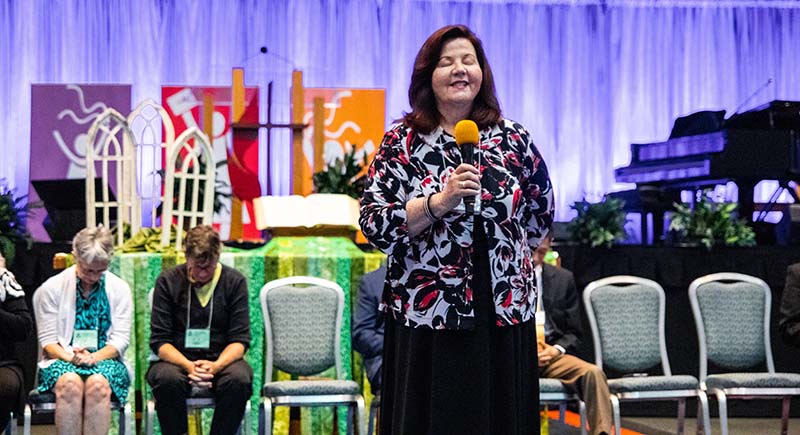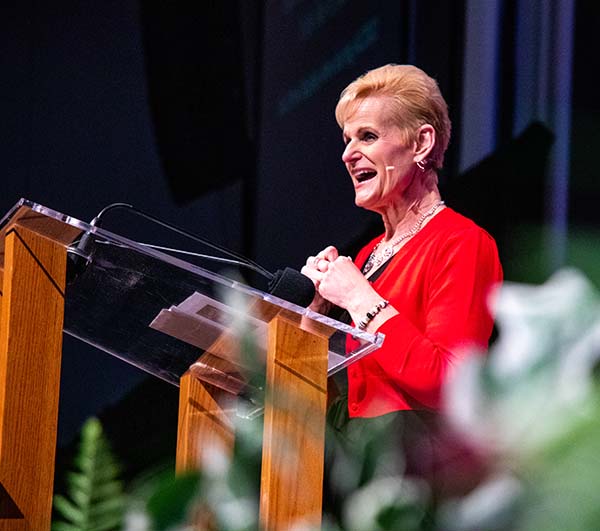
The Rev. Denise Bates, dean of the Cabinet, leads the conference in prayer before the Q&A session on the District Initiative.
District Initiative Q&A
Clergy and lay members of the Virginia Annual Conference gathered in Hampton, VA, Thursday, June 16. The morning started with a Question and Answer time with the appointive Cabinet to discuss the District Initiative Project. Each of the eight district superintendents has been working with a local team to help develop new district structures for district-level work, projected to be starting July 1, 2022. It is anticipated that once the Annual Conference votes on the final number of districts, the new districts will be doing new things all across the conference.
Budget concerns were raised. The Rev. Denise Bates, dean of the Cabinet, explained that the need for being centered around ministry remains. This initiative is a grassroots design. The Rev. Sarah Calvert said it was the experience of the Alexandria and Arlington districts to be very beneficial to work as one district. It made budget and staff decisions easier. The Rev. Doug Forrester, superintendent of the Roanoke and Staunton districts, said they have been working as one unified staff. Training and communications have been unified. It has made each district aware of the ministries they can do together. Victor Gomez of the Harrisonburg and Winchester districts said it is a challenge but it is possible because “we are doing this work through God’s kingdom.”
A question was raised about how can one superintendent care for more pastors. The Rev. Seonyoung Kim, Eastern Shore and Elizabeth River superintendent, said “It has been a great joy” to work with people of both districts. She said she heard from several pastors that they felt heard and supported. “Serving on both districts, working with many churches, is no easy work, however, it depends on how the DS organize their time and strategize how to bring effectiveness and efficiency to the superintendent’s ministry.”
Dr. Hyo Lee of the Richmond and Charlottesville districts said the Charlottesville District will be closing upon the retirement of the administrative staff. The remaining district staff will be working remotely and will utilize church space for meetings to help save money.
Adjusting and adapting will be very much a way of life for us, Bates said. “The Cabinet and leadership are responsive to taking care of our clergy and churches with grace, whether they are leaving or staying”
Laity and Clergy Sessions
Clergy and laity met in separate sessions at 10:30 a.m. to conduct business.
Conference Lay Leader Martha Stokes welcomed lay members to the Laity Session and gave thanks that conference iyours meeting in person for the first time in three years. “This is our first laity session in three years. I thought it needed to be nontraditional, something different. With that in mind, I hope you have familiarized yourself with your duties and the agenda. She thanked the district lay leaders and the Board of Laity for the extra work they have given over the past year to the District Initiative.”

Kay Kotan addresses the Laity Session.
A young adult, Abebayo Ogungbade from the Richmond District, offered an opening prayer.
Stokes said she thought we needed to refocus on the call of the ministry and couldn’t think of a better person to lead this than Kay Kotan. Kotan is the founder of You Unlimited (coaching, consulting, and training company) and Impressions Unlimited (mystery worshiper company). She is also the creator of The Greatest Expedition – a collaboration of more than 20 thought leaders providing resources and insights for a congregational journey to develop new MAPS (ministry action plans) to reach new people in communities.
Kotan greeted the conference. She shared she is a fourth-generation United Methodist. “We all know Methodism was founded as a laity movement,” she said. “It worked really well. Movement is working together. For what? An organized action. Does that describe us today? What did we learn from those early days that might inform our future? What’s in our roots that can help our future?”
Sociologists have done research that said the dramatic rise of Methodism was short-lived. “Since 1968 we have continued to decline,” Kotan said. The laity have stepped back. Laity used to take care of the preaching, the discipling. “We do need clergy but there’s no reason why we shouldn’t hold up our end,” she said. How many have said, “I”m just a lay person? Can we no longer use that word? There is no such thing as just laity.”
Kotan shared a video of two young boys who created a wave in a stadium filled with over 82000 people. “What can we learn from this story? Stay encouraged. There was an outside party that encouraged them. It didn’t work on the first, second, or third try. It took encouragement. They caught a vision and they kept trying until others caught that vision as well.”
She encouraged the laity to start a movement just like Wesley did those many years ago. Sometimes we have to get rid of some old stuff. Do you sense something new is on the horizon? God is on the move.”
She encouraged the laity to think about how much is committed to that one hour on Sunday and move into more community-minded ministries. How are we connecting? We need to be less pastor-centric, she said.
There is a holy disturbance brewing, Kotan declared. She asked, “How will you lead your church to take full advantage of this season – of this opportunity – we have before us? How will you reclaim our Wesleyan roots and become a lay-driven, vital, effective movement? How will you lead your church in a way that leaves a God-sized impact that transforms your community and the people who live in it? How will you reclaim our heritage, our roots, the intention of our forefathers and foremothers that laity lead ministry at the local church? How will you start the movement?” And there it began. The laity in the gathering started their own “wave” in the convention center hall.
